The blue whale is not just the world’s largest living animal; it’s also the largest animal ever to have lived. This huge marine mammal is bigger than the biggest dinosaurs!
On this page is a complete guide to the blue whale.
Meet The Blue Whale
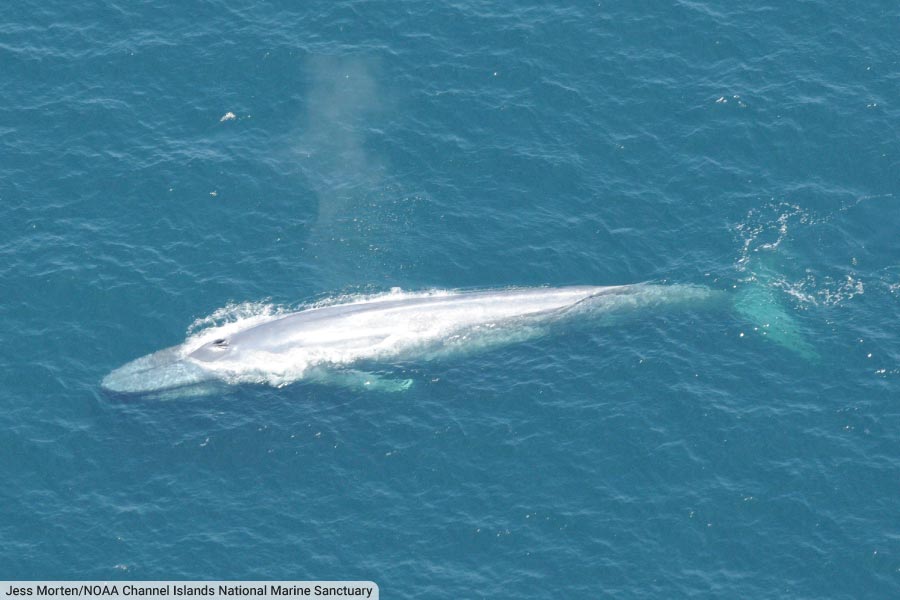
The blue whale (scientific name Balaenoptera musculus) holds the distinction of being the largest known animal ever to have lived on Earth, with individuals reaching up to 100 feet (30 meters) in length and weighing as much as 200 tons. The species is characterized by a mottled bluish-grey body and a broad, flat head.
Despite its enormous size, the blue whale feeds predominantly on small, shrimp-like crustaceans called krill, consuming several tons per day during peak feeding season.
Usually found either alone or in small groups, the blue whale keeps in touch with others with extraordinarily loud and low-pitched vocalizations.
Found in every ocean around the world except the Arctic, the blue whale’s long-distance migration patterns take it from feeding grounds in high-latitude, nutrient-rich waters to warmer breeding and calving areas.
Despite conservation efforts following severe population decline due to whaling in the 20th century, the blue whale remains an endangered species.
Read on for an in-depth guide to the world’s largest animal…
Page Index
- Blue Whale Fun Facts & Statistics
- What Is A Blue Whale?
- How Big Is A Blue Whale?
- What Does A Blue Whale Look Like?
- What Does The Blue Whale Eat?
- How Do Blue Whales Communicate?
- Where Are Blue Whales Found?
- Blue Whale Life Cycle
- Is The Blue Whale Endangered?
- Discover More With Active Wild
Related Pages
- See every whale species on this page: Types of Whales
- Love whales? See an awesome selection of gifts for whale lovers: Whale Gifts
- See every dolphin species on this page: Types of Dolphins
- Visit our main animal page: Animals
Blue Whale Fun Facts
- The blue whale is larger than any known dinosaur.
- A blue whale’s spout can be up to 30 feet (roughly 9 meters) in height.
- The maximum speed of a blue whale is around 18.6 mph / 30 km/h
- The deepest recorded dive of a blue whale was 315 meters (1,033 ft). The longest recorded dive lasted just over 15 minutes.
- Blue whales can live up to 90 years old.
- Blue whales lack teeth, and feed by filtering food from the water using comb-like baleen plates in their mouths.
- A nursing blue whale produces over 50 US gallons / 189.271 Liters of milk a day, and has the largest mammary glands of all mammals. The milk is between 35 and 50 % fat.
- Blue whales are among the fastest growing animals on earth.
- Female whales give birth to a single calf every 2-3 years.
- The heart of a blue whale weighs about 400 pounds (approximately 180 kilograms) – roughly the size of a small piano – and is large enough for a human to crawl through some of its arteries.
- A blue whale's tongue can weigh as much as an elephant - around 2.7 metric tons (about 5,952 pounds). The blue whale's mouth is so large that 50 people could stand inside it, and its tongue is so expansive that multiple people could lie down on it.
Watch a video of a blue whale below:
Blue Whale Statistics
- Scientific Name: Balaenoptera musculus
- Order: Artiodactyla
- Family: Balaenopteridae
- Length: Up to 30 meters (98 feet)
- Weight: Up to 200,000 kg (440,925 lb)
- Where Found: All the world's oceans, except the Arctic, with specific distribution depending on feeding and breeding seasons
- IUCN Conservation Status: Endangered
What Is A Blue Whale?
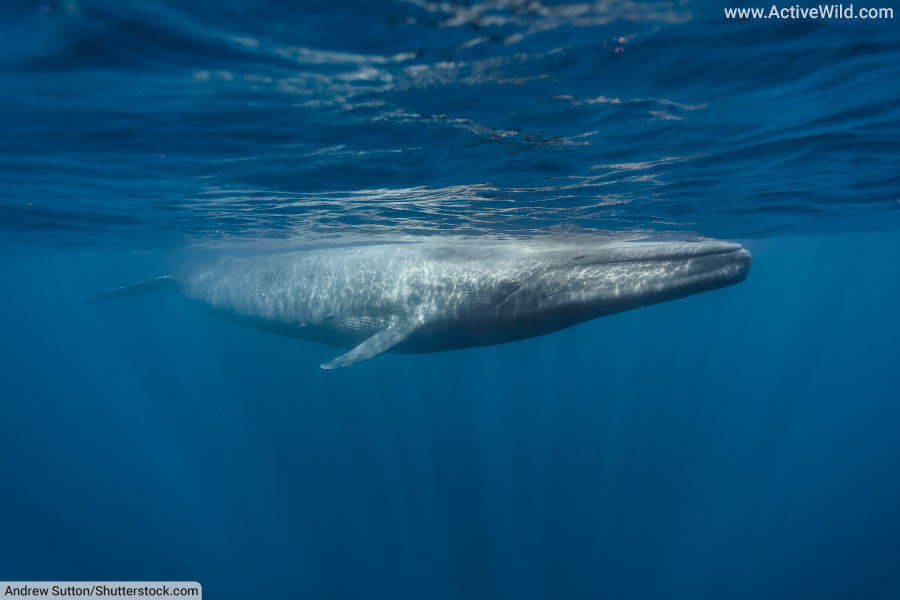
The blue whale is a marine mammal. Like all mammals, it is warm-blooded, breathes air, and gives birth to live young, which are fed by milk produced by the mammary glands of the female.
You can find out more about mammals on these pages:
Whales belong to the infraorder Cetacea, a group of marine mammals whose members are known as cetaceans. Cetacea is home to all whales, dolphins and porpoises.
Cetaceans evolved from terrestrial mammals around 50 million years ago, with their ancestors believed to be similar to present-day ungulates, or hoofed mammals. (The living land mammal most closely related to cetaceans is the hippo.)
Cetacea is divided into two main groups: the baleen whales of parvorder Mysticeti, and the toothed whales of parvorder Odontoceti.
What Type Of Whale Is The Blue Whale?
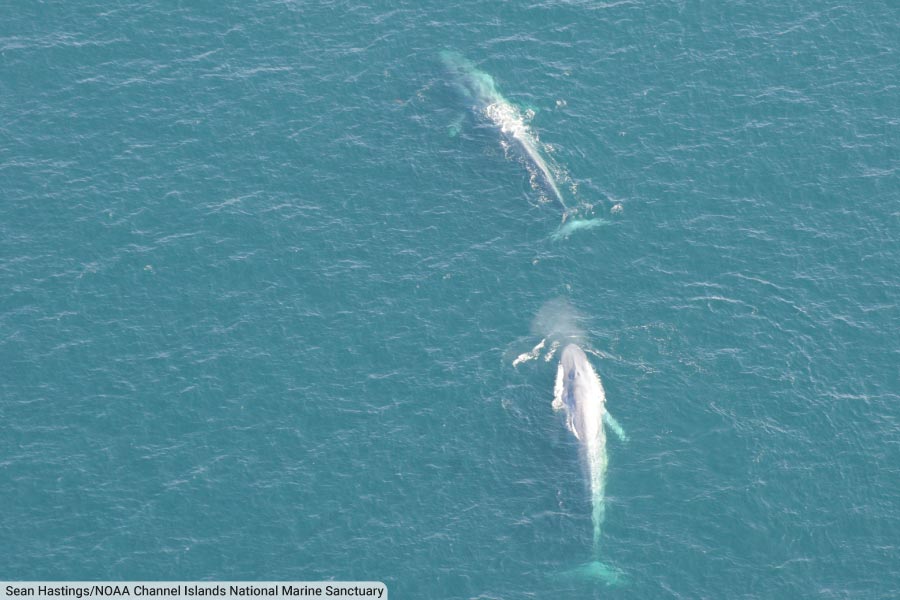
The blue whale is a baleen whale. Baleen whales are characterized by their baleen plates, which they use to filter small prey like krill and plankton from seawater, and typically have two blowholes.
(In contrast, toothed whales have teeth for capturing and eating larger prey, such as fish and squid, and possess a single blowhole.)
Within Mysticeti, the blue whale is a member of the rorqual family (Balaenopteridae), which includes other large whales such as the humpback and the fin whale.
The blue whale is further classified into three subspecies: B. m. musculus in the North Atlantic and North Pacific, B. m. intermedia in the Southern Ocean, and B. m. brevicauda (also known as the pygmy blue whale) in the Indian Ocean and South Pacific Ocean.
How Big Is A Blue Whale?
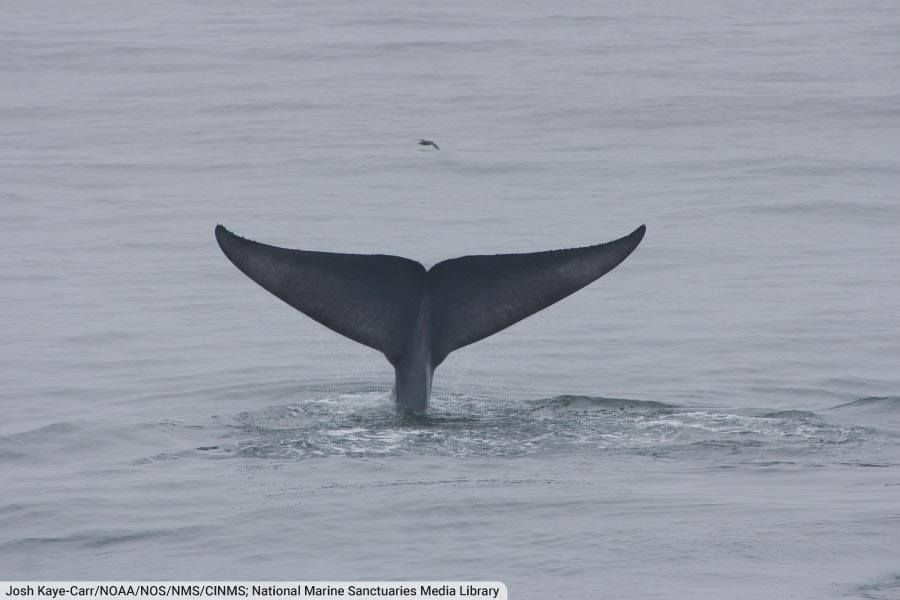
Blue whales are the largest animals ever to have lived on our planet, even out-sizing the largest dinosaurs. They can reach lengths of up to 100 feet (approximately 30 meters).
The heaviest recorded blue whale weighed in at an astonishing 199 tons (approximately 180 metric tonnes), although their typical weight is around 100 to 150 tons (90-136 metric tonnes).
Females are generally larger than males, a phenomenon seen in several whale species.
Why Is The Blue Whale So Big?
The blue whale evolved to its extraordinary size likely driven by an abundance of food (krill) and the lack of evolutionary pressures to remain small, such as predation or habitat constraints. However, the specific factors that led to the blue whale's exceptional size are still a subject of scientific research.
What Does A Blue Whale Look Like?

The body of a blue whale is long and slender, culminating in a broad, flat head that makes up about a quarter of the animal’s total length. The whale’s streamlined shape allows it to travel quickly and efficiently through the water.
The whale’s mouth is equipped with plates of baleen instead of teeth. These comb-like structures are used to filter the whale’s primary food, krill, from the water.
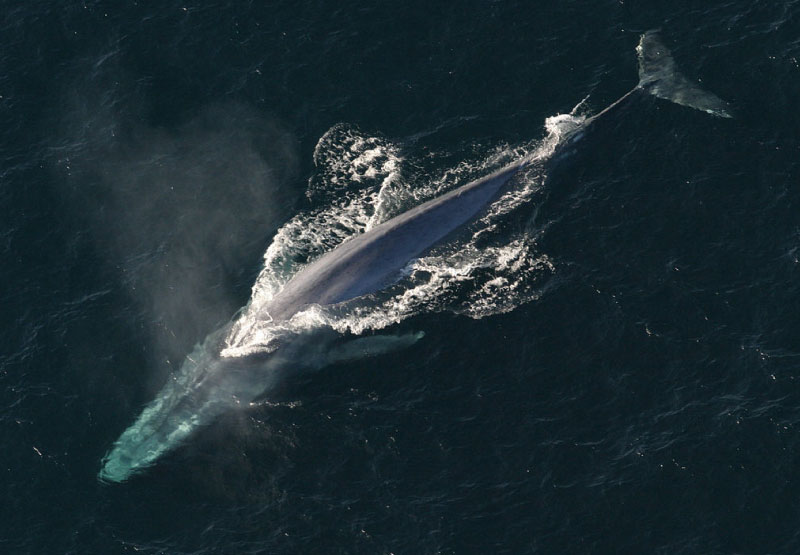
The blue whale’s skin is primarily a mottled bluish-grey, though it can appear different colors in different lighting or when viewed from different angles. The blue whale gets its name from its blue appearance when in the water.
The blue whale has a relatively small dorsal fin set far back on its body and flippers that are around one-seventh of its body length.
The whale’s tail fin, or fluke, can span up to 25 feet (7.6 meters) across and is used to propel the massive creature through the water.
Blue Whale Spout

A blue whale's blow, or spout, can reach impressive heights due to the whale's large size and powerful lungs. The spout is the result of the whale exhaling air through its blowhole upon surfacing. The exhaled air and water vapor can shoot up to about 30 feet (roughly 9 meters) in the air, creating a distinctive tall, straight column that's visible from a distance. It's an iconic sight and often the first sign for whale watchers that a blue whale is present.
What Does The Blue Whale Eat?
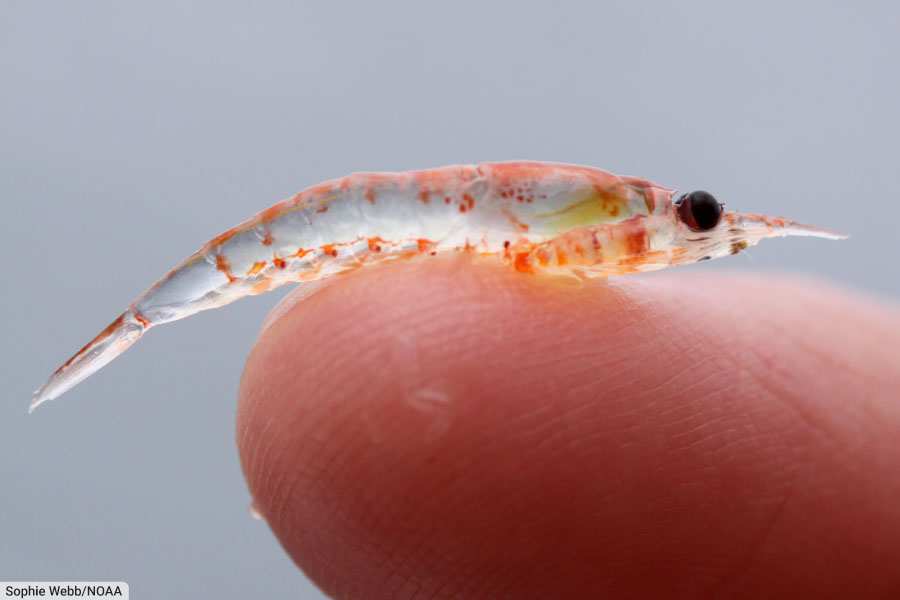
The blue whale’s diet consists almost entirely of krill – shrimp-like crustaceans around 1-2cm in length. An adult whale can eat up to 40 million / 8,000 lbs (3628.74 kg) of krill a day.
The whale can only eat small prey because it has a very narrow oesophagus (throat).
When feeding, the blue whale employs a strategy known as "lunge feeding," in which it accelerates towards a dense swarm of krill, open its mouth widely, and takes in a huge volume of water and krill. The whale then uses its massive tongue to push the water out through the baleen plates, which act as a sieve, trapping the krill inside, which are then swallowed whole.
How Do Blue Whales Communicate?
Blue whales are renowned for their powerful and far-traveling vocalizations, which are among the loudest and lowest frequency sounds made by any animal.
Their vocalizations can reach up to 188 decibels – louder than a jet engine – and their low frequency calls, some as deep as 10 Hz, can travel vast distances across the ocean, potentially up to hundreds of miles under ideal conditions.
The whales produce a variety of sounds, including pulses, buzzes, and rasps, but are most well-known for their haunting, melodic songs, primarily produced by males, whose purpose is thought to be related to communication and mate attraction.
Blue whale songs are highly structured and evolve over time, with each population exhibiting unique vocal patterns.
Where Are Blue Whales Found?
Blue whales are found in all the world's oceans, except the Arctic, with a wide global distribution. They typically inhabit vast, open waters, and their specific range depends largely on the time of year and availability of their preferred prey, krill.
During feeding seasons, blue whales are found in high-latitude, nutrient-rich waters such as the North Atlantic and North Pacific Oceans and the Southern Ocean surrounding Antarctica.
In winter, blue whales migrate to warmer, tropical and subtropical waters to breed and give birth, including along the coasts of Mexico and Costa Rica in the Pacific, the Indian Ocean near Sri Lanka, and the Atlantic Ocean near the Canary Islands.
Notably, blue whales exhibit high fidelity to their feeding and breeding areas, traveling thousands of miles between to the same locations year after year.
The global blue whale population is fragmented and varies regionally, with some areas showing signs of slow recovery since the end of commercial whaling, while others remain critically low.
Blue Whale Life Cycle
Mating occurs typically in warmer, tropical waters. The gestation period lasts approximately 11 to 12 months. Following this, a single calf is born, which can measure up to 8 meters (26 feet) in length and weigh as much as 3 tons.
The newborn is nurtured with its mother's fat-rich milk, which helps it gain about 90 kilograms (200 pounds) each day during the first year of life.
Weaning occurs between 6 to 7 months of age, after which the young whale starts to feed on krill. Blue whales reach sexual maturity at around 5 to 10 years of age, with females tending to mature slightly earlier than males. The breeding frequency for blue whales is every two to three years.
Adult blue whales have few predators, with only some reports of orca pods attacking the very young or weak individuals. However, humans have historically been their most significant threat, hunting them nearly to extinction during the 20th century. Natural lifespan of a blue whale is thought to be around 70 to 90 years, although there are records of individuals living over 100 years.
Is The Blue Whale Endangered?
The blue whale is an endangered species. This is largely due to the extensive commercial whaling during the 19th and 20th centuries that drastically reduced global blue whale populations.
Although commercial whaling was banned by the International Whaling Commission in 1986, blue whale populations have been slow to recover.
Today, blue whales continue to face threats from ship strikes, entanglement in fishing gear and ocean noise pollution, which can interfere with their communication and navigation. Conservation efforts are ongoing to protect and help recover blue whale populations.
Discover More With Active Wild
See every whale species on this page: Types of Whales
Love whales? See an awesome selection of gifts for whale lovers: Whale Gifts
See every dolphin species on this page: Types of Dolphins
Visit our main animal page: Animals

